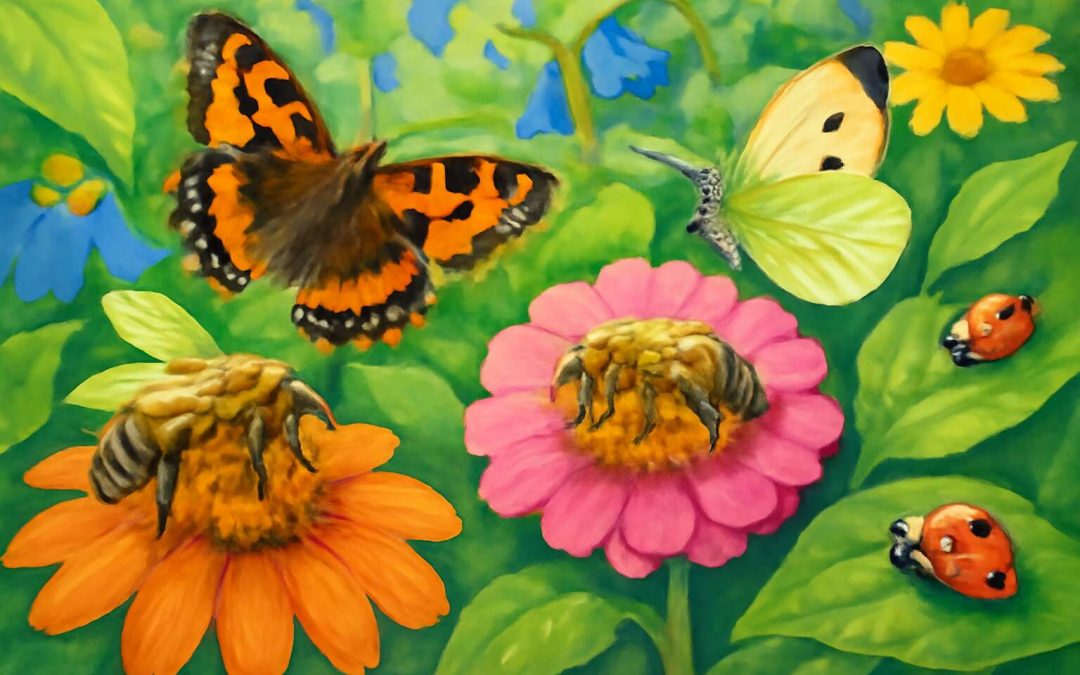Understanding Insects Activity: An Essential Guide
What Influences Insects Activity? – Array
Understanding insects activity requires more than just observing their movements; it demands an exploration of the subtle forces that drive their behaviour. Insects are remarkably sensitive to changes in their environment, and their activity patterns are often a reflection of complex biological rhythms intertwined with external stimuli.
What influences insects activity? Temperature, humidity, and light are primary factors, but the interplay of these elements can create a tapestry of behavioural shifts. For instance, many insects become more active during dawn and dusk, seeking to avoid the oppressive heat of midday or the cold of night. These patterns are not random but are driven by evolutionary adaptations that optimise their survival.
- Ambient temperature
- Availability of food sources
- Predator presence
- Seasonal changes
Each of these elements acts as a catalyst, shaping insects activity in ways that often go unnoticed. Recognising these influences reveals a deeper understanding of their intricate existence—one that oscillates with the rhythms of nature itself.
Types of Insects and Their Activity Patterns – Array
Within the delicate dance of nature, understanding insects activity unveils a world of intricate rhythms and silent symphonies. Each species follows a unique cadence, dictated by the subtle whispers of the environment and the magnetic pull of biological clocks. For example, some moths and beetles are most active during twilight, their movements a graceful response to the cooling air and diminishing light. Such patterns are not merely behavioural quirks but vital adaptations that ensure their survival in a constantly shifting landscape.
Recognising these activity patterns often requires more than passive observation; it involves deciphering a tapestry woven from seasonal shifts, food availability, and predator presence. Certain insects, like bees, thrive in warmer months, their buzzing activity echoing the abundance of flowering plants. Others, such as crickets and cicadas, emerge with the onset of summer’s warmth, their calls woven into the fabric of warm evenings. Understanding insects activity in this context reveals the delicate balance they maintain—an ongoing dialogue with the world around them.
Behavioral Aspects of Insects Activity
Feeding and Foraging Patterns – Array
Insects activity is an intricate ballet of instinct, environment, and survival strategies. Their feeding and foraging patterns are seldom random; instead, they exhibit a remarkable behavioural sophistication that often mirrors the social mores of high society—albeit in a far more frantic and less refined manner. For many insects, the clock dictates their activity, with dawn and dusk serving as prime social hours for gathering sustenance. This behaviour ensures they avoid predators and optimise their foraging efficiency.
Curiously, certain insects display a preference for specific stimuli—be it the scent of nectar or the vibrational cues of potential prey. Their activity can be categorised into distinct phases, often influenced by external factors such as temperature, light, and humidity. These factors orchestrate a fine-tuned dance of movement, where insects exhibit a variety of feeding and foraging patterns that are both strategic and surprisingly social.
- Some insects employ a form of communal foraging, increasing their efficiency through coordinated activity.
- Others adopt solitary pursuits, meticulously avoiding competition and unnecessary risks.
Mating and Reproduction – Array
In the intricate web of insects activity, one cannot overlook the profound significance of their mating and reproductive behaviours. These rituals are far from mere biological necessities; they are a testament to the relentless drive for survival and perpetuation of the species. Each insect species navigates a unique courtship dance, often synchronised with environmental cues that optimise reproductive success.
The timing of these activities is meticulously orchestrated, typically aligned with specific phases of the day or night, ensuring maximum pollination or fertilisation efficiency. Insects often employ an array of stimuli—visual signals, pheromones, or vibrational cues—to attract mates. For example, certain species release potent chemical signals that travel great distances, elevating the importance of chemical communication within insects activity. These signals serve as a silent language, guiding potential partners through a maze of environmental and social factors.
Understanding the behavioural aspects of insects activity during mating reveals a startling sophistication. It is a relentless pursuit, driven by instinct but also shaped by the surrounding ecosystem. This dance of reproduction, often cloaked in secrecy and subtlety, underscores the profound interconnectedness of life’s smallest agents.
Migration and Movement – Array
In the mysterious realm of insects activity, movement and migration are often shrouded in subtlety and precision. These tiny explorers are not merely wandering aimlessly; their journeys are driven by intricate behavioural cues that ensure survival and reproductive success. Some species undertake remarkable migrations, spanning vast distances with uncanny navigation skills, guided by environmental signals and innate instincts.
The behavioural aspects of insects activity during migration reveal a fascinating complexity. For instance, many insects respond to temperature fluctuations, wind patterns, or even lunar cycles, aligning their movements with optimal conditions. This natural choreography often involves synchronized swarming or directional shifts, which can be observed during seasonal changes or ecosystem shifts.
- Temperature cues
- Wind currents
- Moon phases
play pivotal roles in orchestrating these movements, highlighting nature’s silent but powerful communication channels.
Understanding these nuances offers insight into the delicate balance of ecosystems, where insects activity plays a crucial role. Their movement patterns are not random but a testament to evolutionary mastery, ensuring species persistence amidst changing environments. The dance of migration and movement remains one of the most enthralling aspects of insects activity, revealing an ongoing saga of adaptation and survival that continues to mystify scientists and enthusiasts alike.
Monitoring and Studying Insects Activity
Methods to Observe Insects – Array
Monitoring and studying insects activity requires a blend of keen observation and innovative techniques. With each passing season, the subtle movements of insects reveal secrets about their behaviour and environmental health. Employing methods such as light traps, pheromone baits, and direct visual surveys allows researchers to capture a snapshot of insects activity across different habitats. These tools are essential in understanding how insects respond to changes in their environment, offering insights that are both fascinating and vital for ecological balance.
To deepen our understanding, scientists often use specialized recording devices that detect vibrations or electrical signals produced by insects in flight or during communication. Additionally, some researchers rely on marking and recapture techniques, which help track movement patterns and population dynamics. Whether through manual counting or automated sensors, observing insects activity becomes a captivating adventure, illuminating the intricate web of life that pulses just beneath our notice.
- Light traps for nocturnal insects
- Pheromone lures to attract specific species
- Visual surveys for behavioural observations
Each method, carefully chosen and expertly applied, turns the study of insects activity into a vivid exploration of nature’s hidden world.
Tools and Technologies – Array
Understanding insects activity demands precision and cutting-edge technology. Researchers now harness a variety of tools that unlock the secrets of these tiny creatures, revealing their behaviour in ways previously unimaginable. Among the most intriguing are light traps, which lure nocturnal insects by mimicking moonlight, capturing their activity during the darkest hours. These devices not only provide insights into insect populations but also help assess environmental health.
Pheromone lures are another powerful tool, selectively attracting specific insect species through chemical signals. This targeted approach allows scientists to study particular behaviours, such as mating and territory marking, with remarkable accuracy. Visual surveys, meanwhile, offer a direct window into insects activity, enabling researchers to observe behavioural patterns and interactions firsthand.
Advanced recording devices are transforming the field further. From vibration sensors to electrical signal detectors, these innovations identify insect communication and flight patterns, painting a detailed picture of their activity cycles. Employing a combination of these tools, scientists can map the complex web of insect activity across diverse habitats, deepening our understanding of their role within ecosystems.
Importance of Insects Activity Data – Array
Monitoring and studying insects activity provides a window into the delicate balance of ecosystems and the subtle shifts that signal environmental change. When scientists gather detailed data on insect behaviour, they unlock invaluable insights that influence everything from agriculture to conservation efforts. The importance of insects activity data cannot be overstated; it helps us comprehend how seasonal variations, climate shifts, and human intervention impact these tiny yet vital creatures.
Accurate tracking of insects activity enables the identification of emerging patterns, such as early signs of population decline or unexpected migrations. By analysing this data, researchers can anticipate ecological disruptions before they become critical. Employing a blend of traditional and modern observation techniques, the collection of insects activity data becomes a cornerstone of ecological intelligence. It empowers us to make informed decisions that protect biodiversity and sustain the health of our planet’s ecosystems.
Managing Insects Activity for Health and Environment
Reducing Pest Insects Through Activity Control – Array
In the quiet chaos of our shared environment, insects activity emerges as a silent yet potent force shaping both health and ecological balance. Each fleeting movement, each subtle shift in their behaviour, offers a window into the intricate web of life that sustains us all. Understanding how to manage insects activity isn’t merely about control; it’s about recognising their role in our ecosystems and the delicate balance we must preserve.
Reducing pest insects through activity control becomes a moral imperative when considering the broader implications for health and environment. Disrupting their activity patterns—whether by altering habitat conditions or employing targeted interventions—can significantly diminish their impact. Sometimes, simple measures like modifying light sources or removing breeding grounds can curb insects activity without resorting to harsh chemicals. The goal is harmony, not dominance, in the ongoing dance of life.
- Monitoring insect movement to identify peak activity periods
- Implementing natural deterrents that influence insects activity patterns
- Creating barriers that limit migration and movement of pest insects
Supporting Beneficial Insects – Array
In the delicate interplay of our ecosystems, managing insects activity is not merely a matter of control but a conscious effort to support beneficial insects that uphold ecological integrity. These tiny architects of pollination and natural pest regulation are vital to maintaining biodiversity and sustainable agriculture. By fostering environments that encourage their presence, we ensure that their intrinsic roles continue unimpeded, ultimately safeguarding both our health and the environment.
Creating habitat corridors and preserving native flora are essential strategies to support beneficial insects—bees, ladybirds, and pollinating beetles—whose activity patterns often differ markedly from those of pest species. Observing insects activity through innovative tools and technologies allows us to monitor their movement and behaviour, facilitating a balanced approach to insect management. When we understand the nuances of their activity, we can implement measures that reduce pest insects activity without undermining the vital work performed by beneficial insects.
In this nuanced dance of life, the goal is harmony—cultivating environments where beneficial insects thrive while pest insects are kept in check. This symbiotic balance is fundamental to fostering resilient ecosystems and promoting a healthier, more sustainable future. After all, supporting beneficial insects isn’t just an act of environmental stewardship; it’s an investment in the intricate web of life that sustains us all.
Climate Change and Its Impact on Insects Activity – Array
The relentless march of climate change is rewriting the rules of insects activity worldwide. Rising temperatures and unpredictable weather patterns are causing shifts in insect behaviour, often with unforeseen consequences. Some species are emerging earlier in the season, disrupting established ecological balances, while others struggle to adapt to rapid environmental changes. This fluctuation in insects activity can have cascading effects on pollination, pest control, and overall biodiversity.
As we witness these transformations, understanding how climate change influences insects activity becomes vital. It’s no longer just about observing insects in their natural habitat; it’s about deciphering the subtle signals that reveal how global warming impacts their movement, feeding, and reproduction. These insights are crucial to developing strategies that support resilient ecosystems capable of withstanding climatic upheavals.

